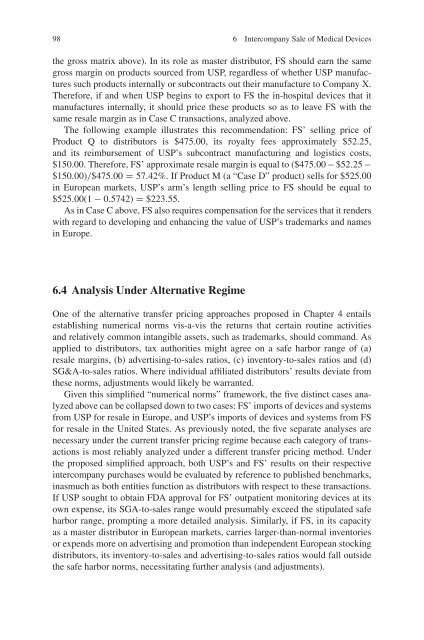Contents - AL-Tax
Contents - AL-Tax
Contents - AL-Tax
Create successful ePaper yourself
Turn your PDF publications into a flip-book with our unique Google optimized e-Paper software.
98 6 Intercompany Sale of Medical Devicesthe gross matrix above). In its role as master distributor, FS should earn the samegross margin on products sourced from USP, regardless of whether USP manufacturessuch products internally or subcontracts out their manufacture to Company X.Therefore, if and when USP begins to export to FS the in-hospital devices that itmanufactures internally, it should price these products so as to leave FS with thesame resale margin as in Case C transactions, analyzed above.The following example illustrates this recommendation: FS’ selling price ofProduct Q to distributors is $475.00, its royalty fees approximately $52.25,and its reimbursement of USP’s subcontract manufacturing and logistics costs,$150.00. Therefore, FS’ approximate resale margin is equal to ($475.00 − $52.25 −$150.00)/$475.00 = 57.42%. If Product M (a “Case D” product) sells for $525.00in European markets, USP’s arm’s length selling price to FS should be equal to$525.00(1 − 0.5742) = $223.55.As in Case C above, FS also requires compensation for the services that it renderswith regard to developing and enhancing the value of USP’s trademarks and namesin Europe.6.4 Analysis Under Alternative RegimeOne of the alternative transfer pricing approaches proposed in Chapter 4 entailsestablishing numerical norms vis-a-vis the returns that certain routine activitiesand relatively common intangible assets, such as trademarks, should command. Asapplied to distributors, tax authorities might agree on a safe harbor range of (a)resale margins, (b) advertising-to-sales ratios, (c) inventory-to-sales ratios and (d)SG&A-to-sales ratios. Where individual affiliated distributors’ results deviate fromthese norms, adjustments would likely be warranted.Given this simplified “numerical norms” framework, the five distinct cases analyzedabove can be collapsed down to two cases: FS’ imports of devices and systemsfrom USP for resale in Europe, and USP’s imports of devices and systems from FSfor resale in the United States. As previously noted, the five separate analyses arenecessary under the current transfer pricing regime because each category of transactionsis most reliably analyzed under a different transfer pricing method. Underthe proposed simplified approach, both USP’s and FS’ results on their respectiveintercompany purchases would be evaluated by reference to published benchmarks,inasmuch as both entities function as distributors with respect to these transactions.If USP sought to obtain FDA approval for FS’ outpatient monitoring devices at itsown expense, its SGA-to-sales range would presumably exceed the stipulated safeharbor range, prompting a more detailed analysis. Similarly, if FS, in its capacityas a master distributor in European markets, carries larger-than-normal inventoriesor expends more on advertising and promotion than independent European stockingdistributors, its inventory-to-sales and advertising-to-sales ratios would fall outsidethe safe harbor norms, necessitating further analysis (and adjustments).
















